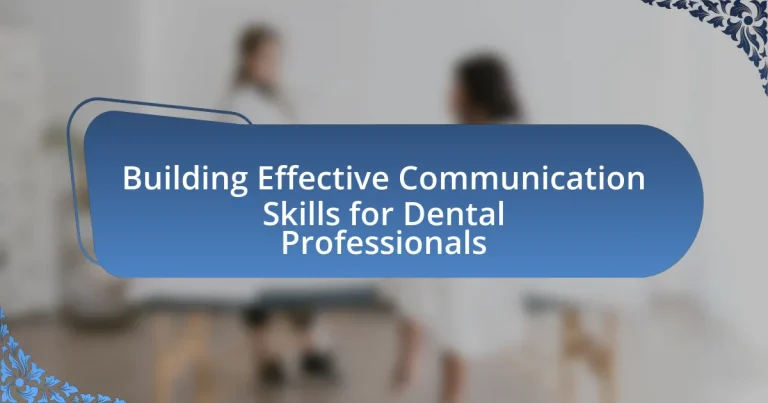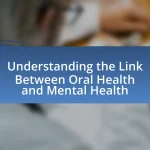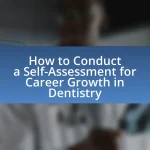The article focuses on building effective communication skills for dental professionals, emphasizing the importance of active listening, clear verbal and non-verbal communication, empathy, and patient education. It outlines how effective communication enhances patient understanding, trust, and satisfaction, ultimately leading to better health outcomes. The article also addresses the role of communication in team dynamics, common challenges faced by dental professionals, and strategies to overcome these obstacles, including the use of technology and feedback. Key components of effective communication, such as clarity and active listening, are highlighted, along with practical tips for improving interactions with patients and colleagues.

What are Effective Communication Skills for Dental Professionals?
Effective communication skills for dental professionals include active listening, clear verbal communication, non-verbal communication, empathy, and the ability to educate patients. Active listening ensures that dental professionals fully understand patient concerns, which is crucial for accurate diagnosis and treatment. Clear verbal communication involves using simple language to explain procedures and treatment options, making it easier for patients to comprehend. Non-verbal communication, such as maintaining eye contact and using appropriate body language, helps build trust and rapport with patients. Empathy allows dental professionals to connect with patients on an emotional level, enhancing the patient experience. Lastly, the ability to educate patients about oral health and preventive care empowers them to make informed decisions, ultimately leading to better health outcomes.
Why is communication important in dental practice?
Communication is important in dental practice because it enhances patient understanding, trust, and satisfaction. Effective communication allows dental professionals to clearly explain treatment options, procedures, and potential outcomes, which is crucial for informed consent. Studies show that patients who understand their treatment plans are more likely to adhere to recommendations, leading to better health outcomes. Additionally, strong communication skills foster a positive patient-provider relationship, which can reduce anxiety and improve the overall patient experience.
How does effective communication impact patient care?
Effective communication significantly enhances patient care by fostering trust, improving patient understanding, and ensuring adherence to treatment plans. When dental professionals communicate clearly and empathetically, patients are more likely to feel valued and understood, which can lead to increased satisfaction and better health outcomes. Research indicates that effective communication can reduce patient anxiety and improve compliance with treatment recommendations, as patients who understand their conditions and treatment options are more likely to engage in their care actively. For instance, a study published in the Journal of Dental Education found that effective communication skills among dental professionals led to higher patient satisfaction scores and improved treatment outcomes, demonstrating the critical role of communication in delivering quality patient care.
What role does communication play in team dynamics?
Communication is essential in team dynamics as it fosters collaboration, enhances understanding, and improves overall performance. Effective communication enables team members to share information clearly, express ideas, and provide feedback, which leads to better decision-making and problem-solving. Research indicates that teams with strong communication practices experience higher levels of trust and cohesion, resulting in increased productivity and job satisfaction. For instance, a study published in the Journal of Applied Psychology found that teams with open communication channels were 25% more effective in achieving their goals compared to those with poor communication.
What are the key components of effective communication?
The key components of effective communication are clarity, active listening, empathy, and feedback. Clarity ensures that the message is easily understood, which is crucial in a dental setting where precise information is necessary for patient care. Active listening involves fully concentrating on the speaker, which fosters trust and understanding between dental professionals and patients. Empathy allows practitioners to connect with patients on an emotional level, enhancing the patient experience and compliance with treatment plans. Feedback, both giving and receiving, is essential for confirming understanding and improving future interactions. Research indicates that effective communication can significantly improve patient satisfaction and treatment outcomes, highlighting its importance in dental practice.
What verbal skills are essential for dental professionals?
Dental professionals require essential verbal skills such as active listening, clear articulation, and empathetic communication. Active listening enables dental professionals to fully understand patient concerns and needs, fostering trust and rapport. Clear articulation is crucial for explaining treatment options and procedures in a way that patients can easily comprehend, which enhances patient compliance and satisfaction. Empathetic communication allows dental professionals to connect with patients on an emotional level, addressing anxieties and building a supportive environment. These skills are supported by studies indicating that effective communication significantly improves patient outcomes and satisfaction in dental care settings.
How do non-verbal cues influence communication in dentistry?
Non-verbal cues significantly influence communication in dentistry by conveying emotions, building trust, and enhancing patient understanding. For instance, a dentist’s facial expressions, gestures, and posture can reassure anxious patients, making them feel more comfortable during procedures. Research indicates that 93% of communication effectiveness is determined by non-verbal cues, highlighting their critical role in patient interactions. Additionally, maintaining eye contact can foster a sense of connection, while a warm smile can create a welcoming environment, ultimately improving patient satisfaction and compliance with treatment plans.
How can dental professionals improve their communication skills?
Dental professionals can improve their communication skills by actively engaging in training programs focused on interpersonal communication and patient interaction. Research indicates that effective communication enhances patient satisfaction and treatment outcomes, as evidenced by a study published in the Journal of Dental Education, which found that dental students who participated in communication skills workshops reported increased confidence and improved patient rapport. Additionally, practicing active listening, using clear and simple language, and seeking feedback from patients can further enhance their ability to convey information effectively.
What training options are available for enhancing communication skills?
Training options available for enhancing communication skills include workshops, online courses, and role-playing exercises specifically designed for dental professionals. Workshops often provide hands-on experience and feedback from peers and instructors, while online courses offer flexibility and a variety of topics, such as patient interaction and conflict resolution. Role-playing exercises simulate real-life scenarios, allowing dental professionals to practice and refine their communication techniques in a safe environment. These methods have been shown to improve patient satisfaction and treatment outcomes, as effective communication is crucial in the dental field.
How can feedback be utilized to improve communication?
Feedback can be utilized to improve communication by providing specific insights into how messages are received and understood. When dental professionals actively seek and incorporate feedback from patients and colleagues, they can identify areas of misunderstanding or miscommunication. For instance, a study published in the Journal of Dental Education found that incorporating patient feedback significantly enhanced the clarity of communication regarding treatment plans, leading to improved patient satisfaction and adherence to care. This demonstrates that feedback serves as a critical tool for refining communication strategies, ensuring that messages are clear, relevant, and effectively tailored to the audience’s needs.
What challenges do dental professionals face in communication?
Dental professionals face several challenges in communication, including language barriers, patient anxiety, and varying levels of health literacy. Language barriers can hinder effective communication with patients who speak different languages, making it difficult to convey important information about treatment options and procedures. Patient anxiety often leads to misunderstandings, as anxious individuals may not fully engage in discussions or may misinterpret information. Additionally, varying levels of health literacy among patients can complicate the communication process, as some may struggle to understand dental terminology or instructions, leading to confusion about their care. These challenges can impact the quality of care and patient satisfaction, highlighting the need for improved communication strategies in dental practice.
How can language barriers affect patient interactions?
Language barriers can significantly hinder patient interactions by creating misunderstandings and reducing the quality of care. When patients and healthcare providers do not share a common language, it can lead to miscommunication regarding symptoms, treatment options, and medication instructions. A study published in the Journal of General Internal Medicine found that patients with limited English proficiency are more likely to experience adverse health outcomes due to these communication challenges. This evidence underscores the importance of effective communication in healthcare settings, particularly in dentistry, where precise information exchange is crucial for patient safety and satisfaction.
What strategies can be employed to overcome communication challenges?
To overcome communication challenges, dental professionals can employ strategies such as active listening, clear and concise messaging, and the use of visual aids. Active listening involves fully concentrating on the speaker, which enhances understanding and reduces miscommunication. Clear and concise messaging ensures that information is conveyed without ambiguity, which is crucial in a clinical setting where precise instructions are necessary. The use of visual aids, such as diagrams or models, can help bridge gaps in understanding, particularly when explaining complex procedures or conditions. These strategies are supported by research indicating that effective communication significantly improves patient satisfaction and treatment outcomes in dental practices.
How does technology influence communication in dental practices?
Technology significantly enhances communication in dental practices by facilitating real-time information sharing and improving patient engagement. Digital platforms, such as practice management software and telehealth services, enable dental professionals to communicate efficiently with patients and staff, streamlining appointment scheduling, treatment planning, and follow-up care. For instance, a study published in the Journal of Dental Education found that the use of electronic health records (EHR) improved communication accuracy and reduced errors in patient information transfer. Additionally, tools like patient portals allow for secure messaging, enabling patients to ask questions and receive timely responses, which fosters a more collaborative relationship between patients and dental providers.
What tools can enhance communication with patients?
Digital communication tools such as patient portals, telehealth platforms, and secure messaging systems can enhance communication with patients. Patient portals allow patients to access their health information, schedule appointments, and communicate with healthcare providers, improving engagement and understanding. Telehealth platforms facilitate remote consultations, making it easier for patients to receive care without the need for in-person visits. Secure messaging systems enable quick and confidential communication, allowing patients to ask questions and receive timely responses. Research indicates that effective use of these tools can lead to increased patient satisfaction and adherence to treatment plans, as evidenced by a study published in the Journal of Medical Internet Research, which found that patients using digital communication tools reported better health outcomes and improved communication with their providers.
How can digital platforms improve team communication?
Digital platforms can improve team communication by providing real-time messaging, video conferencing, and collaborative tools that facilitate instant information sharing and feedback. These platforms, such as Slack and Microsoft Teams, enable dental professionals to communicate efficiently, reducing misunderstandings and enhancing collaboration on patient care. Research indicates that organizations using digital communication tools experience a 25% increase in productivity due to streamlined communication processes, which is crucial in a fast-paced environment like dental practices.
What are the best practices for effective communication in dentistry?
The best practices for effective communication in dentistry include active listening, clear and concise explanations, and the use of visual aids. Active listening ensures that dental professionals fully understand patient concerns, which fosters trust and rapport. Clear and concise explanations help patients comprehend treatment options and procedures, reducing anxiety and improving compliance. The use of visual aids, such as diagrams or models, enhances understanding and retention of information. Research indicates that effective communication can lead to higher patient satisfaction and better health outcomes, as evidenced by a study published in the Journal of Dental Education, which found that improved communication skills among dental students correlated with increased patient trust and satisfaction.
How can active listening improve patient relationships?
Active listening can significantly improve patient relationships by fostering trust and understanding between dental professionals and their patients. When dental professionals engage in active listening, they demonstrate genuine interest in patients’ concerns, which can lead to increased patient satisfaction and adherence to treatment plans. Research indicates that effective communication, including active listening, enhances the therapeutic alliance, resulting in better health outcomes. For instance, a study published in the Journal of Dental Education found that patients who felt heard and understood were more likely to follow through with recommended dental care, highlighting the importance of active listening in building strong patient relationships.
What techniques can be used to convey complex information clearly?
Techniques to convey complex information clearly include the use of visual aids, simplification of language, and structured organization of content. Visual aids, such as diagrams and charts, help to illustrate complex concepts, making them more accessible. Simplifying language involves using everyday terms instead of jargon, which enhances understanding among diverse audiences. Structured organization, such as breaking information into smaller, manageable sections, allows for easier navigation and retention of key points. Research indicates that these methods significantly improve comprehension and retention, as evidenced by studies showing that visual learning can enhance understanding by up to 400%.
What are common pitfalls in dental communication and how to avoid them?
Common pitfalls in dental communication include using technical jargon, failing to listen actively, and not addressing patient concerns adequately. To avoid these pitfalls, dental professionals should simplify language to ensure patient understanding, practice active listening by summarizing patient concerns, and create an open environment for questions. Research indicates that effective communication can enhance patient satisfaction and compliance, as evidenced by a study published in the Journal of Dental Education, which found that clear communication significantly improves patient outcomes.
What misunderstandings frequently occur in patient communication?
Misunderstandings in patient communication often arise from unclear medical terminology, assumptions about patient knowledge, and cultural differences. Medical professionals frequently use jargon that patients may not understand, leading to confusion about diagnoses or treatment plans. Additionally, healthcare providers may assume patients have a certain level of understanding about their health conditions, which can result in miscommunication. Cultural differences can also play a significant role, as varying beliefs and practices may affect how patients interpret information. Research indicates that effective communication strategies, such as using plain language and confirming patient understanding, can mitigate these misunderstandings.
How can dental professionals ensure clarity in their messages?
Dental professionals can ensure clarity in their messages by using simple language, avoiding jargon, and actively listening to patients. Simple language helps patients understand complex dental concepts, while avoiding jargon prevents confusion. Active listening allows dental professionals to gauge patient understanding and address any misconceptions immediately. Research indicates that effective communication in healthcare settings improves patient satisfaction and adherence to treatment plans, highlighting the importance of clarity in messages.
What practical tips can dental professionals implement to enhance communication?
Dental professionals can enhance communication by actively listening to patients, using clear and simple language, and providing visual aids to explain procedures. Active listening ensures that dental professionals fully understand patient concerns, which fosters trust and rapport. Utilizing clear language avoids misunderstandings, as medical jargon can confuse patients. Additionally, visual aids, such as diagrams or models, help patients grasp complex information, making them feel more informed and involved in their care. These strategies are supported by studies indicating that effective communication improves patient satisfaction and treatment outcomes.


